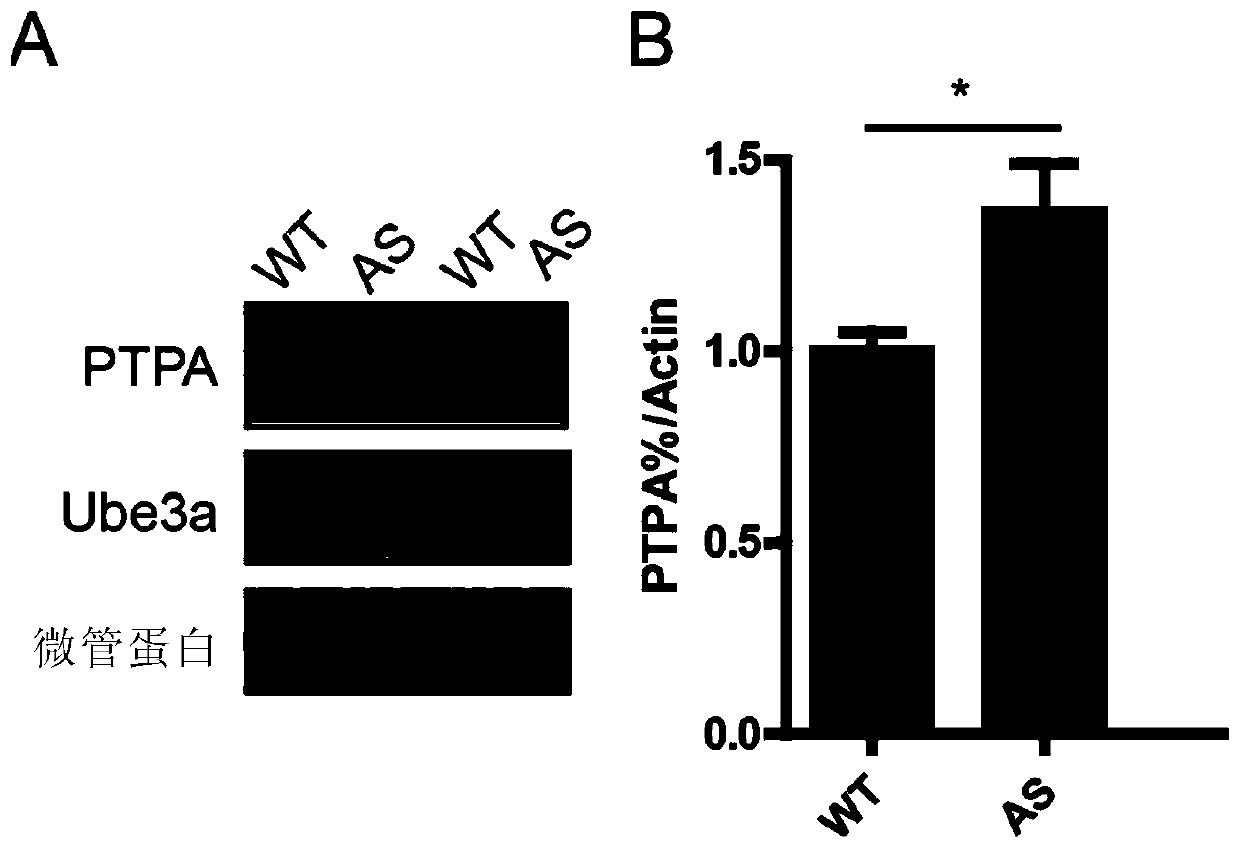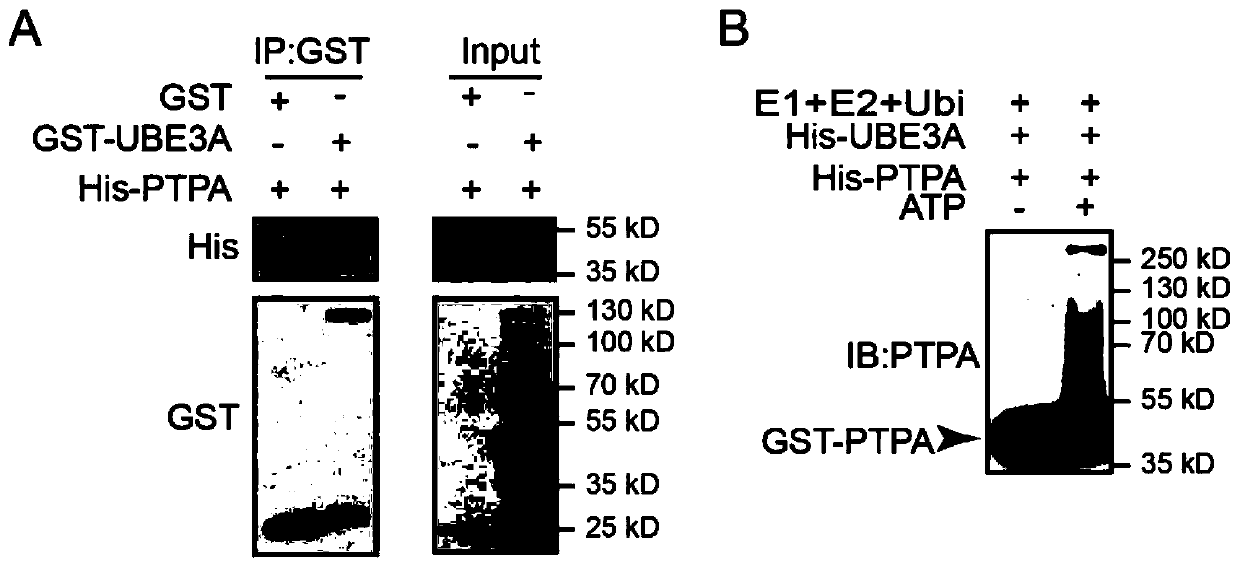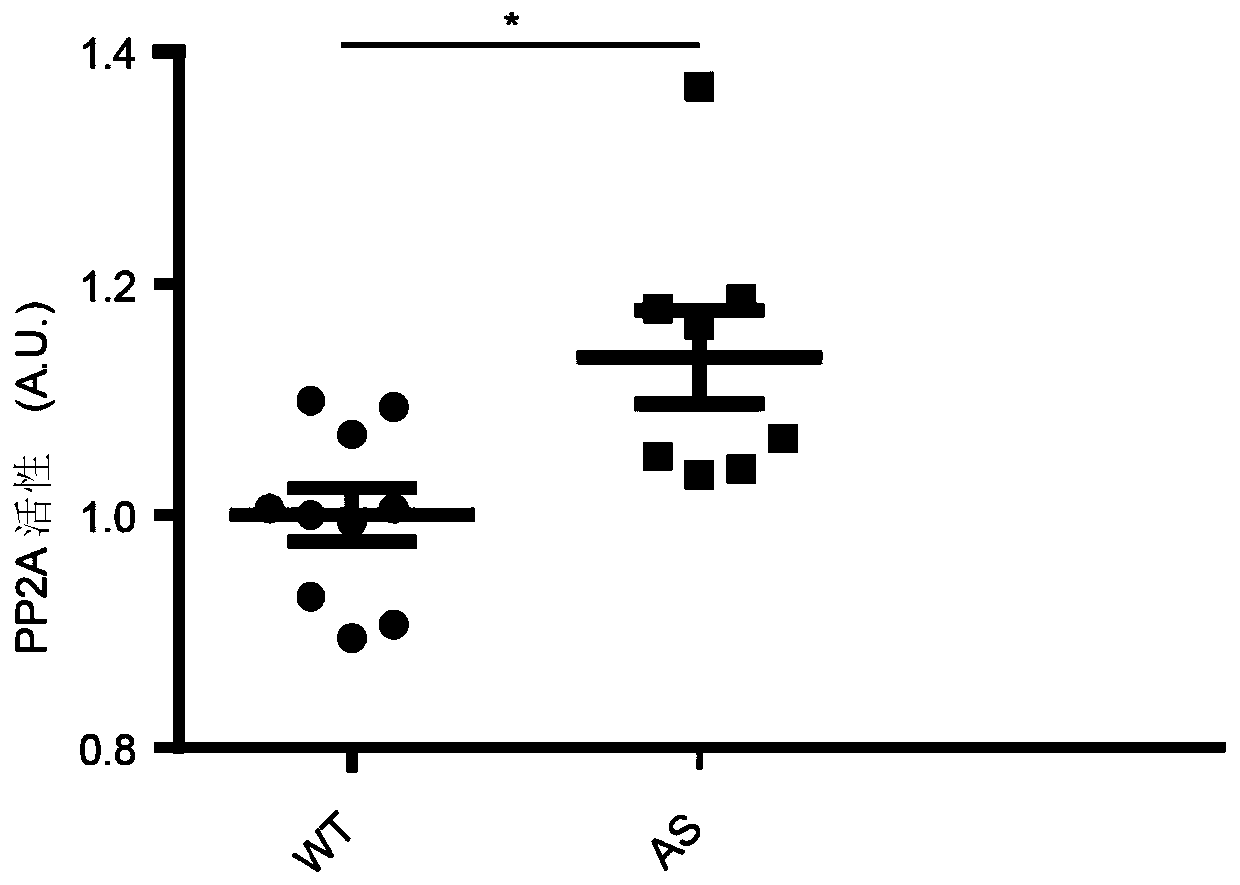Application of Ube3a-ubiquitinated protein phosphatase 2A (PP2A) activating factor, namely tyrosine phosphatase activating factor (PTPA), for treating Angelman syndrome and autism
A technology for syndromes and activating factors, applied in the fields of molecular biology and pharmacology, can solve problems that cannot explain neurodevelopmental disease phenotypes well
- Summary
- Abstract
- Description
- Claims
- Application Information
AI Technical Summary
Problems solved by technology
Method used
Image
Examples
Embodiment 1
[0318] Example 1, Detection of PTPA protein level in Ube3a deficient mice
[0319] First, 30-day-old (P30) mice were taken out: wild-type (WT) and littermate AS mice with maternal deletion of Ube3a (obtained from Duke University, a termination was introduced under exon 2 of Ube3a codon, resulting in the non-expression of Ube3a), anesthetized, and injected 0.7% sodium pentobarbital intraperitoneally according to the standard of 70mg / kg; Put it into pre-cooled 0.9% normal saline, wash away the blood with normal saline, put it on sterile filter paper, use tweezers and hippocampal spoon to dissect the brain tissue, put half of the cerebellum tissue into a 2ml Axygen centrifuge tube, and then Put 400ul of RIPA lysate with 1mM PMSF into it, put a 3mm diameter magnetic bead into a tissue homogenizer, break it at 60Hz for 30s, take it out, and put it on ice for 30min. Afterwards, in a refrigerated centrifuge at 4°C, centrifuge at 14000 g for 20 min, then take the supernatant into a n...
Embodiment 2
[0339] Example 2, UBE3A ubiquitination of PTPA
[0340] 1) GST pull-down
[0341] Purification of GST-tagged protein: The constructed prokaryotic expression plasmid (PGEX-4T-1 or Pgex-4T-1-UBE3A) was transformed into a competent Rosetta expression strain, and spread on an ampicillin-resistant plate. After the colonies grow out, pick the colonies and place them in 5 mL of LB bacterial culture medium containing antibiotics, culture them overnight at 37 degrees Celsius and 250 rpm. The overnight cultured bacteria were inserted into the LB bacterial medium to which antibiotics had been added at a ratio of 1:100, and cultured at 37°C until OD600=0.6-0.8 (about 2.5 hours). Then add IPTG (0.168mM) and induce for 5 hours at 27°C. The induced bacterial liquid was centrifuged at 12000rpm for 2 minutes and collected into a 15mL centrifuge tube. Add 5 mL of GST lysis buffer (PBS+1% TritonX-100, 1 mM PMSF) to resuspend the cells. Ultrasonic at 80-100W for 5 seconds, with an interval of...
Embodiment 3
[0350] Example 3, Detection of PP2A activity in Ube3a deficient mice
[0351] The whole brain of the mouse was taken out according to the method in Example 1, it was put into a pre-cooled glass homogenizer, and 1ml of imidazole lysate (20mM imidazole hydrochloride (PH7.0), 2mM EDTA, 2mM EGTA, 1mM PMSF , 5ul Protease Inhibitor Cocktail (P8430)), homogenate about 20 times, transfer the lysate to a 1.5ml centrifuge tube with a pipette, and insert it into an ice box. Put the centrifuge tube into a refrigerated centrifuge, centrifuge at 3000g for 5min at 4°C. Take out the supernatant into a new centrifuge tube, and measure the protein concentration according to the method in Example 1.
[0352]Take 500ug of protein into a new 1.5ml centrifuge tube, make up the volume to 500ul with imidazole lysate, and complete the detection of PP2A activity according to the steps provided by the PP2A activity detection kit (Moker Millipore, #17-313). Specifically, 4ug of Anti i-PP2A, C (#05-421)...
PUM
 Login to View More
Login to View More Abstract
Description
Claims
Application Information
 Login to View More
Login to View More - R&D
- Intellectual Property
- Life Sciences
- Materials
- Tech Scout
- Unparalleled Data Quality
- Higher Quality Content
- 60% Fewer Hallucinations
Browse by: Latest US Patents, China's latest patents, Technical Efficacy Thesaurus, Application Domain, Technology Topic, Popular Technical Reports.
© 2025 PatSnap. All rights reserved.Legal|Privacy policy|Modern Slavery Act Transparency Statement|Sitemap|About US| Contact US: help@patsnap.com



